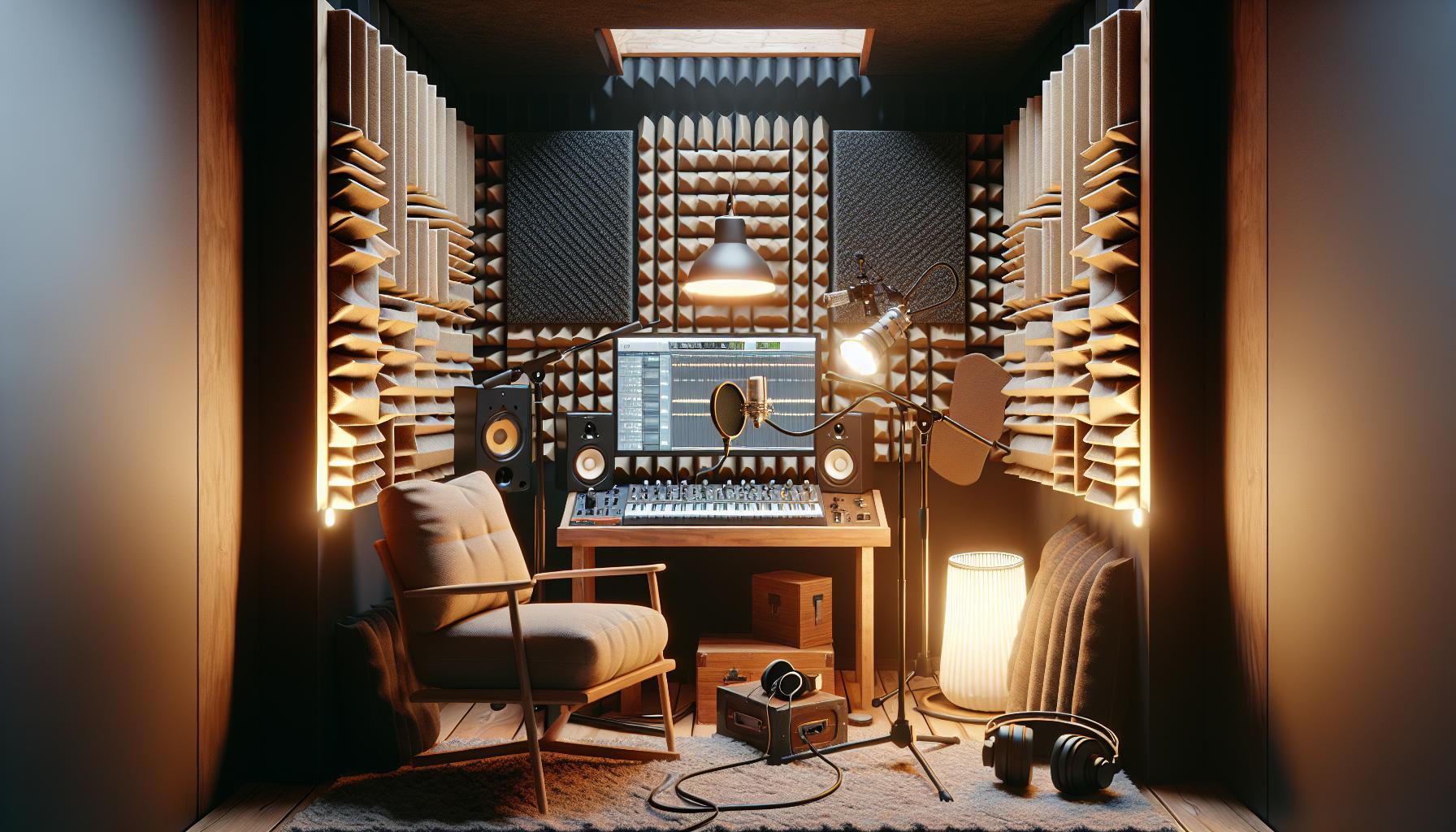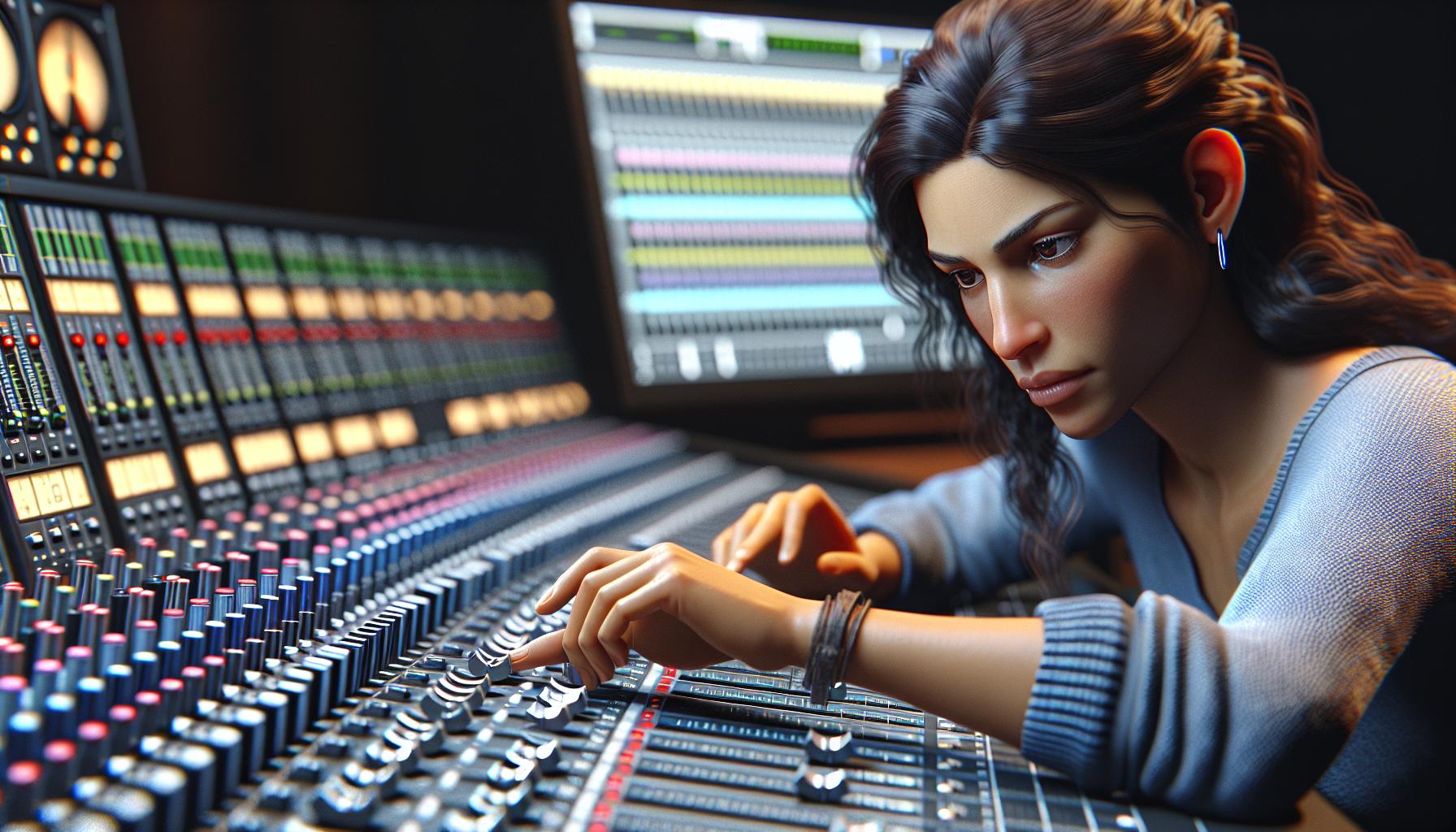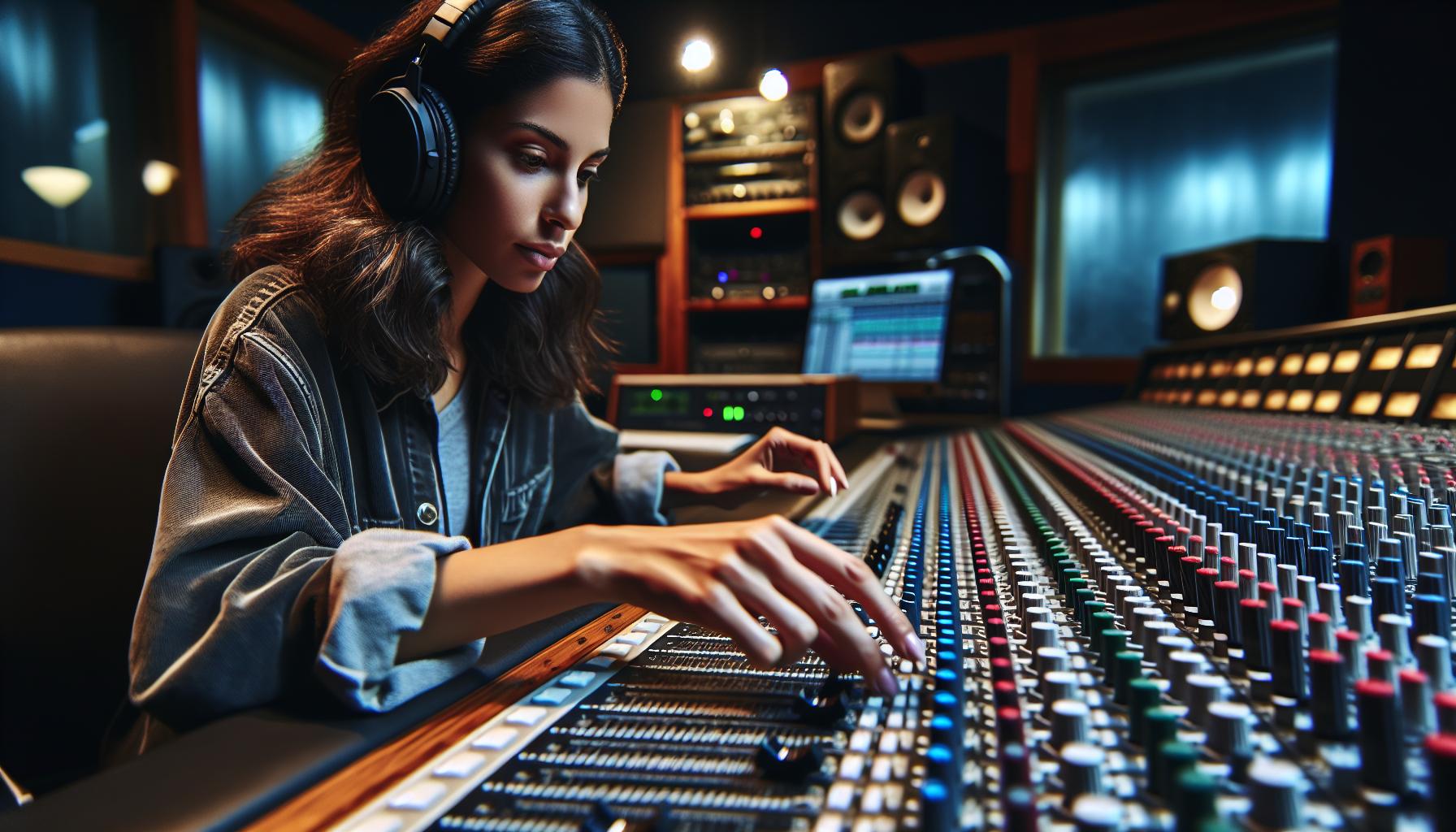When it comes to mixing vocals, it’s not just about getting the right pitch or tone. It’s about blending the lead and background vocals to create a harmonious sound. I’ve spent years experimenting with different techniques, and I’m here to share my insights.
First off, let’s talk about the lead vocals. They’re the star of the show, the voice that carries the melody. But even the most talented singer can’t carry a song alone. That’s where the background vocals come in. They add depth and richness, supporting the lead vocals and enhancing the overall sound.
Contents
Choosing the Right Microphone
In the voyage of achieving the perfect vocal mix, one factor remains commonly overlooked: choosing the right microphone. It’s not enough to simply grab the nearest one and begin recording. Microphones, like artists, have their unique personalities and characteristics.
Before exploring microphone options, it’s vital to understand the singer’s voice. Pay attention to the range, tone, and other characteristics to get a clear picture of what the vocals will bring to your mix. Among the vast sea of available microphones, some perform better with certain types of voices or singing styles. Put simply, the right microphone can greatly enhance the recording session and the resulting mix.
Several microphone types are available to choose from, including dynamic, condenser, and ribbon mics. Each type lends a unique quality to recorded vocals. While dynamic mics are durable and resistant to moisture, condenser microphones capture sound accurately, making them ideal for studio recording. Ribbon mics, on the other hand, are known for their smooth and vintage tonality.
Below is a basic run-down of these types:
| Microphone Type | Key Characteristics |
|---|---|
| Dynamic | Durable, moisture-resistant, great for live performances |
| Condenser | Accurate sound capture, ideal for studio recordings |
| Ribbon | Smooth & vintage tonality, sensitive handling required |
Make no mistake, the microphone alone won’t solve all your mixing issues. However, it can be a robust ally in your quest for the perfect vocal blend. It’s also crucial to remember—there’s no ‘one size fits all.’ Experiment with different mics until you find the perfect match. After all, that’s what mixing vocals is all about: finding the sweet spot and bringing music to life.
Remember, the goal isn’t just to get your vocals in tune, but to capture the essence of the performance in its truest form. The right microphone can help you do just that.
Setting Up the Recording Space

The process of capturing an excellent vocal performance doesn’t stop at choosing the right microphone. The space in which recording happens plays a pivotal role too. You might have come across a wide variety of recording spaces – from professionally designed studios with perfect acoustics to makeshift booths in bedrooms. The key here is not necessarily having the most expensive setup but knowing how to maximize what you’ve got.
First things first, let’s focus on eliminating unwanted noise. It’s maybe tempting to decide you’ll handle this in post-production, but believe me, addressing this issue at source will significantly streamline your mixing process. Consider the acoustical properties of the room. Hard surfaces can cause reflections, leading to a boxy, muddy sound. Adding some absorptive material, like foam paneling, can help tame these reflections. A rule of thumb: the more controlled the environment, the better the recorded vocals will sound.
Next, let’s talk about Microphone Placement. Positioning the microphone correctly can greatly impact the quality of the recorded vocals. Experiment with different placements: test varying distances between the singer and the microphone. Understand what suits the artist’s voice and style the best.
Don’t be afraid to think outside the box. For instance, if the room has a particularly high ceiling or a distinctive feature, try using it to add depth and character to the vocals. We’re not striving for a sterile, zero echo environment but a balanced one that compliments the vocals.
Lastly, it’s essential to create a comfortable space for the performer. This might seem secondary but a relaxed artist delivers a better performance. Ensure adequate lighting, a decent monitor mix, and a comfortable temperature in the room. These factors can put the artist at ease and help evoke their best performance, therefore, enhancing the overall quality of your recording.
It’s crucial to understand that tailoring the recording space to the artist and the song can add a layer of professionalism to your mixes that software alone cannot accomplish. Keep tweaking and experimenting to find what works best for you and the artist. Remember, in audio, there are no hard rules – only guidelines.
Leveling the Lead Vocals

After setting up the perfect recording space and capturing the essence of the performance, it’s time for the next phase in our journey – leveling the lead vocals. This stage plays a crucial role in the mixing process, refining the vocals’ dynamics so they sit well in the track.
When starting the leveling part, I often engage the vocal track’s faders, ensuring that the lead vocals aren’t overwhelming the rest of the track. Striking a balance is the main goal. One helpful technique is to use a reference track – a professionally mixed song with a similar style to guide our mix.
Automating the vocal level is another pivotal technique I use. Instead of maintaining a static level, automation can help the vocals breathe and adapt throughout the song. This method enhances the emotional impact. Furthermore, it brings out subtle details in the artist’s performance.
Use of level automation to highlight significant moments in the performance:
- Quieter verses to build anticipation
- Louder and brighter choruses to deliver an impact
- Breath sounds and lyrical nuances for added emotional depth
Considering the audio analysis data, here’s a simple representation:
| Parameter | Ideal Range |
|---|---|
| Verses | -18 to -23 dBFS |
| Choruses | -14 to -18 dBFS |
| Breath Sounds/Lyrical Nuances | -23 to -28 dBFS |
These values should be used as a starting point, the final levels will depend on the mix’s specific demands.
Automation and careful fader work indeed act as effective tools, contributing to a balanced, polished mix. However, remember that every artist, song, and mix will demand a unique approach in leveling. It’s all about adjusting to the groove, the vibe and the individual style of the performer. Let’s move on to the techniques of mixing background vocals in our next section – a vital part of our mixing journey.
EQ and Compression for Lead Vocals
Diving into the depths of Equalization (EQ) and compression, I find these two as crucial elements in achieving a high-quality lead vocal mix. EQ allows me to unleash certain frequencies, making the vocals shine through the mix. On the flip side, compression works to ensure the lead vocals smoothly integrate with the entire track by managing the dynamics.
For effective lead vocal EQing, a cut-before-boost approach serves me well. This method involves identifying and cutting out troublesome frequencies – typically those in the lower-mid range that muddy the vocals – before enhancing frequencies that add character. This approach not only primes the vocals to cut through the mix but also maintains the track’s overall tonal balance.
When applying EQ, I adopt:
- A High-pass filter at around 80-100Hz. This removes any low rumble from the vocal recording.
- Subtle frequency cuts at around 200-500Hz. This zone often houses boxiness and muddiness.
- Boosting subtly in the 2-6kHz area for clarity and presence. Overdoing this can risk harshness.
As for compression? It’s all about controlling the dynamics while maintaining the vocal’s natural expression. I aim for a compression ratio between 3:1 to 6:1, adjusting the attack and release times according to the vocalist’s performance and the song’s tempo.
One tip to bear in mind with compression is to apply it in stages; a tad during recording, a bit more during the mixing process, and a dash in the final mastering stage. This cumulative stage compression approach allows the lead vocals to remain dynamic and expressive while smoothing out any dynamic irregularities.
Now that the lead vocals have the spotlight they deserve, let’s turn our attention to the unsung heroes in a song – the background vocals. They might not carry the lead melody, but they’re essential in supporting and enriching the overall harmonic structure.
Panning and Reverb for Background Vocals

As we further delve into the art of vocal mixing, the technique of panning offers a unique avenue to imbue depth and space to our soundstage. Panning pertains to the tactic of distributing the sound into a stereo field. Particularly with background vocals, judicious use of this tool can expound on the fullness and richness of your mix, thus giving it a more professional feel and sound.
In simple terms, it’s about deciding whether to position the background vocal to the left, right, or center of your stereo field. But it’s not as easy at it sounds, a kind of ‘sweet spot’ balance has to be achieved. Generally, I advise keeping your lead vocals at the center, while the background vocals should be panned to the left and right to create a fuller, wider sound.
In conjunction with panning, the use of reverb can elevate the quality of your mix. It helps blend the background vocals seamlessly into the track, enabling them to support and complement the lead vocals. Remember, the goal here isn’t to overpower the lead vocals but to provide a supportive layer. Typically, a hall or plate reverb with a decay time of 1.5 to 2 seconds works best for background vocals.
It’s about experimenting with differing amounts of reverb, finding what fits best with your song. Some genres like rock and pop may require less reverb, allowing the background vocals to sit closer in the mix. On the other hand, in genres like country and gospel, more reverb might be appreciated to create a more spacious sound.
Keep in mind, though, reverb should be used with discretion as too much of it can make your mix sound distant and unclear. A good rule of thumb is to adjust the reverb level until it’s just noticeable, then dial it back slightly until it blends naturally with the mix.
Now that we’ve dwelled into panning and reverb for background vocals, let’s move onto another pivotal piece of the puzzle – adding effects and automation to vocals. More on that in the upcoming section.
Finding the Perfect Balance
We’ve delved into the nitty-gritty of panning and reverb, but that’s just scratching the surface. Now, it’s time for the real magic of mixing – finding the perfect balance. Think of your track as a three-dimensional space. How well you populate this space with different sounds can make or break your mix.
Ride the faders during the mixdown process. This phase makes for a dynamic and pulsing mix. Each element should have its moment in the spotlight. But at the same time, they’ve to work together to create a cohesive sound.
When working with lead vocals, consider the song genre and its emotion or mood. Melancholic ballads may require a more prominent lead vocal, while energetic rock songs might allow for louder guitars and drums.
For background vocals, it’s a different ball game. Balance varies based on the song’s arrangement and message. Here’s a general rule – background vocals should be softer than lead vocals. Yet, they should be loud enough to enhance the overall track texture.
Adjust volumes using your ears, not your eyes. Don’t be swayed by volume meters. Music is, after all, for listening, isn’t it?
Automation plays a crucial role too. It helps to create variation and interest within a song. By subtly altering various elements like volume, panning, and effects, you can bring your mix to life. Use it to enable different parts of the song to shine at different times.
Remember, there’s no set formula for attaining the perfect balance. It’s down to what sounds right. You may need to make several tweaks and revisions until you achieve that satisfied nod of approval.
Next up, we’ill be discussing how to add effects and automation to vocals. Stay tuned for tips that will boost your mix to the next level.
Conclusion
Perfecting the art of mixing vocals isn’t something you’ll master overnight, but with patience and practice, it’s definitely achievable. Remember, finding the balance is key. Each component of your track deserves its moment to shine, but they must also work together to form a harmonious sound. Your ears are your best tool in this process, not the volume meters. Don’t be afraid to play around with the volumes of your lead and background vocals to suit the genre and arrangement of your song. Automation can be your best friend, adding that much-needed variation and interest. Stick with me as we delve deeper into adding effects and automation to vocals in the next section. Happy mixing!
